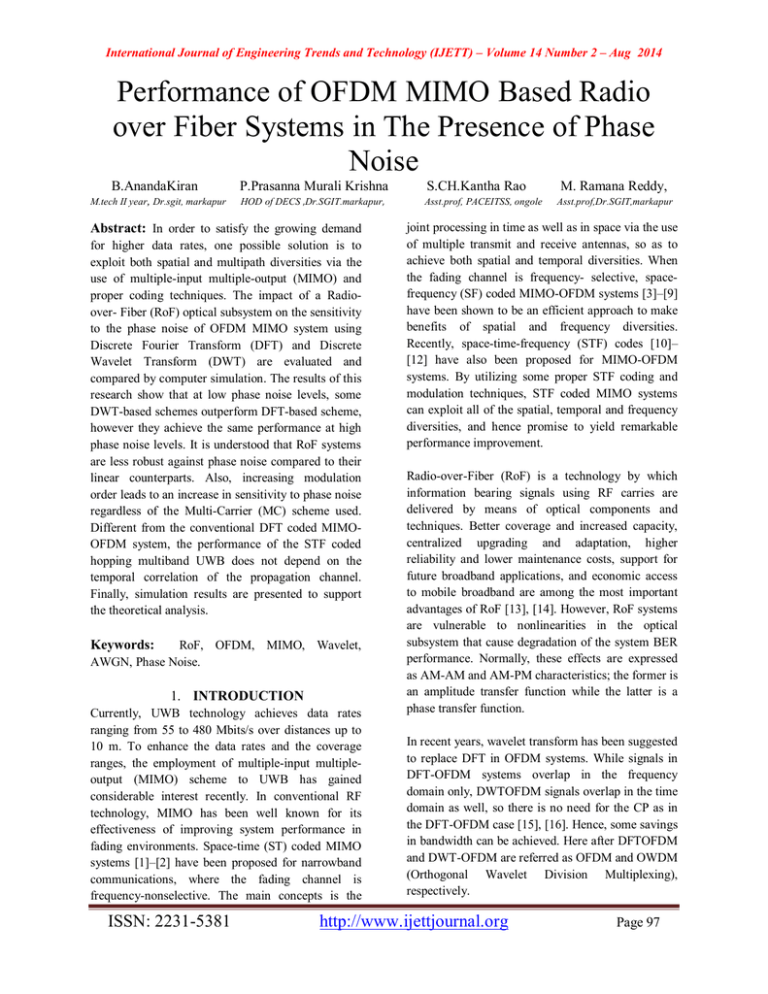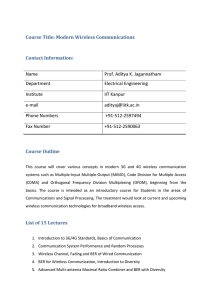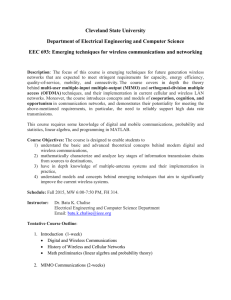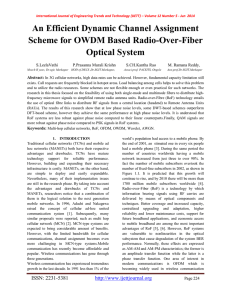Performance of OFDM MIMO Based Radio Noise
advertisement

International Journal of Engineering Trends and Technology (IJETT) – Volume 14 Number 2 – Aug 2014 Performance of OFDM MIMO Based Radio over Fiber Systems in The Presence of Phase Noise B.AnandaKiran M.tech II year, Dr.sgit, markapur P.Prasanna Murali Krishna S.CH.Kantha Rao HOD of DECS ,Dr.SGIT.markapur, Asst.prof, PACEITSS, ongole Abstract: In order to satisfy the growing demand for higher data rates, one possible solution is to exploit both spatial and multipath diversities via the use of multiple-input multiple-output (MIMO) and proper coding techniques. The impact of a Radioover- Fiber (RoF) optical subsystem on the sensitivity to the phase noise of OFDM MIMO system using Discrete Fourier Transform (DFT) and Discrete Wavelet Transform (DWT) are evaluated and compared by computer simulation. The results of this research show that at low phase noise levels, some DWT-based schemes outperform DFT-based scheme, however they achieve the same performance at high phase noise levels. It is understood that RoF systems are less robust against phase noise compared to their linear counterparts. Also, increasing modulation order leads to an increase in sensitivity to phase noise regardless of the Multi-Carrier (MC) scheme used. Different from the conventional DFT coded MIMOOFDM system, the performance of the STF coded hopping multiband UWB does not depend on the temporal correlation of the propagation channel. Finally, simulation results are presented to support the theoretical analysis. Keywords: RoF, OFDM, MIMO, Wavelet, AWGN, Phase Noise. 1. INTRODUCTION Currently, UWB technology achieves data rates ranging from 55 to 480 Mbits/s over distances up to 10 m. To enhance the data rates and the coverage ranges, the employment of multiple-input multipleoutput (MIMO) scheme to UWB has gained considerable interest recently. In conventional RF technology, MIMO has been well known for its effectiveness of improving system performance in fading environments. Space-time (ST) coded MIMO systems [1]–[2] have been proposed for narrowband communications, where the fading channel is frequency-nonselective. The main concepts is the ISSN: 2231-5381 M. Ramana Reddy, Asst.prof,Dr.SGIT,markapur joint processing in time as well as in space via the use of multiple transmit and receive antennas, so as to achieve both spatial and temporal diversities. When the fading channel is frequency- selective, spacefrequency (SF) coded MIMO-OFDM systems [3]–[9] have been shown to be an efficient approach to make benefits of spatial and frequency diversities. Recently, space-time-frequency (STF) codes [10]– [12] have also been proposed for MIMO-OFDM systems. By utilizing some proper STF coding and modulation techniques, STF coded MIMO systems can exploit all of the spatial, temporal and frequency diversities, and hence promise to yield remarkable performance improvement. Radio-over-Fiber (RoF) is a technology by which information bearing signals using RF carries are delivered by means of optical components and techniques. Better coverage and increased capacity, centralized upgrading and adaptation, higher reliability and lower maintenance costs, support for future broadband applications, and economic access to mobile broadband are among the most important advantages of RoF [13], [14]. However, RoF systems are vulnerable to nonlinearities in the optical subsystem that cause degradation of the system BER performance. Normally, these effects are expressed as AM-AM and AM-PM characteristics; the former is an amplitude transfer function while the latter is a phase transfer function. In recent years, wavelet transform has been suggested to replace DFT in OFDM systems. While signals in DFT-OFDM systems overlap in the frequency domain only, DWTOFDM signals overlap in the time domain as well, so there is no need for the CP as in the DFT-OFDM case [15], [16]. Hence, some savings in bandwidth can be achieved. Here after DFTOFDM and DWT-OFDM are referred as OFDM and OWDM (Orthogonal Wavelet Division Multiplexing), respectively. http://www.ijettjournal.org Page 97 International Journal of Engineering Trends and Technology (IJETT) – Volume 14 Number 2 – Aug 2014 In wavelet transform, a signal is decomposed into shifted and scaled versions of a particular wavelet called the mother wavelet [15], [16], [17]. The reverse operations are carried out to reconstruct the original signal. Therefore, not only can the CP be removed in MIMO but also P/Sand S/P blocks can be removed from the MIMO transmitter and receiver, respectively. In coherent communication systems, the receiver must provide carrier and symbol synchronization capabilities. Misalignment between oscillator frequencies of receiver and transmitter or Doppler shift will result in carrier frequency offset , or equivalently, a phase error of the received signal relative to the transmitted signal [4], [10]. Carrier Frequency Offset (CFO) destroys the orthogonality between subcarriers and therefore prevents perfect alignment of FFT bins with peaks of the Sinc shaped pulses. As a result the energy of each subcarrier is spread to other subcarriers leading to Inter-Carrier Interference (ICI). This paper investigates the impact of an optical subsystem of an OFDM/MIMObased multicarrier (MC) RoF system on the BER performance in the presence of phase noise. 2. SYSTEM DESIGN MODEL 2.1 OFDM MIMO Model With the increasing demand for data rate and reliability in Wireless communications and devices, several issues become very important like bandwidth efficiency, quality of service and radio coverage. Because the radio spectrum is almost fully occupied, hence time and frequency domains are also fully occupied. The MIMO-based CR system under consideration is shown in Fig.1. The pilots are designed according to the result of the spectrum sensing. After subcarrier assignment where the subcarriers occupied by the primary users are deactivated, pilot symbols are inserted and the data are modulated on the remaining activated sub carriers. We employ the MIMO concept in our simulation platform because it has been proven that MIMO can achieve a major breakthrough in providing reliable wireless communication links. Figure 1 : MIMO setup The space domain can deal with these limitations. Exploring the spatial domain can be done in several manners and is called spatial diversity. In this thesis we explore the spatial diversity by having multiple transmitters and multiple receivers. The challenges we face when we apply MIMO with OFDM, where implementing MIMO in OFDM is explored and proper solutions are provided. When having multiple transmits and receive antennas, the signal (data) is transmitted through a number of different independent paths in a multipath fading environment. Hence different replicas of the transmitted signal are received. During propagation through the wireless channel the received signal will undergo different (independent) channel fades providing spatial diversity. Signals obtained form different diversity channels have to be combined at the receiver to detect the transmitted symbol. In a uniform scattering environment, half wavelength spacing is sufficient to obtain independent fading channels are shown in fig:2. Fig.2 Block Diagram of MIMO RoF. ISSN: 2231-5381 http://www.ijettjournal.org Page 98 International Journal of Engineering Trends and Technology (IJETT) – Volume 14 Number 2 – Aug 2014 We propose a general framework to characterize the performance of RoF-MIMO systems with multiband OFDM. A combination of STF coding and hopping multiband Rof transmission is proposed to exploit all of the available spatial and frequency diversities. In the performance evaluation, we do not impose any restriction on the delays or the average powers of the multipath components, and the proposed framework is applicable for any channel models. 2.2 Channel estimation of noise presence The channel estimation is applied by the aid of pilots. The pilots are multiplexed with the transmitted data at the transmitting side and further at the receiver the pilots are separated from the data. We show the pilot grids that we designed for the two transmitters in the MIMO OFDM system. There are three different grids which have been proposed and tested. In designing the pilot grids for MIMO, the pilot grid orthogonality between each transmit antenna should be taken care of. Fulfilling the orthogonality between the frames, the channel state information on each channel/link can be properly estimated. After propagation through the wireless channel, multiple replicas of the transmitted frames will arrive at the receiver side. Due to MIMO, at each receiver the frames from both transmitters will be received. Hence the received frame at each receiver will be the combination of the two transmitted patterns, they will add up together. The resulting frame forms the desired type pilot pattern. Due to the orthogonality of the pilot grid of each transmit antenna, the receiver can separate the pilots for each transmit antenna. The pilot distance either in time or frequency direction in both patterns has to fulfill the sampling theorem. The coherence time and coherence bandwidth determines the sampling period. 2.3 Rof communication system Radio-over-Fibre (RoF) technology entails the use of optical fibre links to distribute RF signals from a central location (head end) to Remote Antenna Units (RAUs). In narrowband communication systems and WLANs, RF signal processing functions such as frequency up-conversion, carrier modulation, and multiplexing, are performed at the BS or the RAP, and immediately fed into the antenna. RoF makes it possible to centralize the RF signal processing functions in one shared location (head end), and then to use optical fiber, which offers low signal loss (0.3 ISSN: 2231-5381 dB/km for 1550 nm, and 0.5 dB/km for 1310 nm wavelengths) to distribute the RF signals to the RAUs, as shown in Figure 3. Fig:3 The Radio over Fiber System Concept Fig.2 indicates a simple WDM technology between multiplexer and de-multiplexer where each sender and its receiver uses a specific wavelength along an optical fiber. Dense wavelength division multiplexing furthers the transmission capacity of trunk lines [11]. In general, the modern high-speed DWDM technologies have been built of many transmission spans. It is composed of an erbium doped fiber amplifier, a single-mode fiber transmission section and a part of dispersion compensating fiber or a chirped fiber brag grating (FBG) [12]. 3. SIMULATION RESULTS Reliable and comfortable radio networks are demanded in the modern communication system. Radio over fiber system indicates an advanced technology for transmission data. The radio signal has been sent by mobile user, would be modulated and transmitted over an optical fiber channel in lightwave styles. For our proposed ordering schemes, we have to configure the number of branches. We considering http://www.ijettjournal.org Page 99 International Journal of Engineering Trends and Technology (IJETT) – Volume 14 Number 2 – Aug 2014 the tradeoff between computational complexity and the performance. The indexes of branches which are selected into the codebook are for the FSB scheme. It is presented that the performance of the proposed MB-SIC detectors outperforms the linear MMSE detector, V-BLAST and MMSE-PIC detector. 4. CONCLUSION The maximum achievable diversity advantage of OFDM-MIMO system. In contrast to the conventional OFDM, the factor comes from the band hopping approach, which is regardless of the temporal correlation of the channel. In this paper the impact of a RoF optical sub-system on the BER performances of OFDM and MIMO were assessed in the presence of phase noise. It was found that RoF systems are less robust to phase noise compared to their linear counterparts. Finally, MQAM signals are more robust to phase noise than MPSK signals in a RoF system. Performance assessment of the aforementioned modulation schemes in the presence of colored phase noise, both in AWGN and time varying RF channels. [5] R. Blum, Y. Li, J.Winters, and Q. Yan, “Improved space-time coding for MIMO-OFDM wireless communications,” IEEE Trans. Commun., vol. 49, pp. 1873–1878, Nov. 2001. [6] H. Bölcskei and A. J. Paulraj, “Space-frequency coded broadband OFDM systems,” in IEEE Wireless Commun. Networking Conf., Sep. 2000, pp. 1–6. [7] W. Su, Z. Safar, M. Olfat, and K. J. R. Liu, “Obtaining fulldiversity space-frequency codes from space-time codes via mapping,” IEEE Trans. Signal Process., vol. 51, no. 11, pp. 2905– 2916, Nov. 2003. [8] W. Su, Z. Safar, and K. J. R. Liu, “Full-rate full-diversity space-frequency codes with optimum coding advantage,” IEEE Trans. Inf. Theory, vol. 51, no. 1, pp. 229–249, Jan. 2005. [9] , “Systematic design of space-frequency codes with full rate and full diversity,” in IEEEWireless Commun. Networking Conf., vol. 3, Mar. 2004, pp. 1436–1441. [10] Y. Gong and K. B. Letaief, “Space-frequency-time coded OFDM for broadband wireless communications,” in IEEE Global Telecommun. Conf., vol. 1, Nov. 2001, pp. 519–523. [11] A. F. Molisch, M. Z. Win, and J. H. Winters, “Space-timefrequency (STF) coding for MIMO-OFDM systems,” IEEE Commun. Lett., vol. 6, no. 9, pp. 370–372, Sep. 2002. [12] W. Su, Z. Safar, and K. J. R. Liu, “Towards maximum achievable diversity in space, time and frequency: Performance analysis and code design,” IEEE Trans. Wireless Commun., vol. 4, no. 4, pp. 1847–1857, Jul. 2005. [13] H. Al-Raweshidy, and S. Komaki,” Radio over-Fiber Technologies for Mobile Communications Networks”, Artech House, 2002. [14] J. Mitchell, “Performance of OFDM at 5.8 GHz using radio over fibre link,” Electronics Letters, vol. 40, No. 21, pp. 1353 – 1354, October 2004. [15] Sobia Baig, Fazal-ur-Rehman, M. junaid Mughal ,“Performance Comparison of DFT, Discrete Wavelet Packet and Wavelet Transforms, in an OFDM Transceiver for Multipath Fding Channel”, IEEE Communication Magazine,2004 [16] Deepak Gupta, Torry Harris, Vipin B Vats, Kamal K. Garg,“ Performance Analysis of DFT-OFDM,DCT-OFDM and DWTOFDM in AWGN channel”, IEEE,The Fourth International Conference on Wireless Mobile Communications,2007. [17] F. Farrukh, S. Baig, and M. J. Mughal ,“Performance Comparison of DFT-OFDM and Wavelet-OFDM with ZeroForcing Equalizer for FIR Channel Equalization”, IEEE Communication Magazine,2008. 5. REFERENCES [1] S. Alamouti, “A simple transmit diversity technique for wireless communications,” IEEE J. Sel. Areas Commun., vol. 16, no. 8, pp. 1451–1458, Oct. 1998. [2] V. Tarokh, H. Jafarkhani, and A. R. Calderbank, “Space-time block codes from orthogonal designs,” IEEE Trans. Inf. Theory, vol. 45, no. 5, pp. 1456–1467, Jul. 1999. [3] B. M. Hochwald and T. L. Marzetta, “Unitary space-time modulation for multiple-antenna communication in Rayleigh flat fading,” IEEE Trans. Inf. Theory, vol. 46, pp. 543–564, Feb. 2000. [4] D. Agrawal, V. Tarokh, A. Naguib, and N. Seshadri, “Spacetime coded OFDM for high data-rate wireless communication over wideband channels,” in IEEE Conf. Vehicular Tech., vol. 3, 1998, pp. 2232–2236. ISSN: 2231-5381 http://www.ijettjournal.org Page 100





